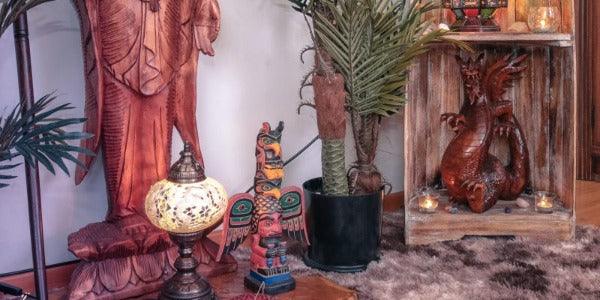Stories, rights, dances, tributes and cultural records of members of clans, families or a community of aboriginal peoples of the northwest coast of the Pacific Ocean were carved in red cedar trunks with symbolic aesthetics to create the monumental pole or Canadian totem - sculptures monuments with indigenous paintings , erected during the potlatch ceremony.
The unique aesthetic of indigenous art and the historic role of totem poles have made them part of Canada's cultural heritage, the institution of which was made under First Nations suppression and revocation of political rights, as well as territorial encroachment and culture appropriation to boost Canadian tourism. That is why it is a powerful symbol of resistance of the Amerindian peoples , which is present in parks, museums and interiors in miniatures as decorative arts .

Totem poles are sculptures with significant symbols carved as memorials.
The poles were constituted with more than one overlapping creature featuring human beings or animals such as eagle, bear, wolf, frog, fish, etc., painted with vibrant colors portraying the lineage of a clan (genealogy), celebrating the ancestry and memory of a deceased member, greeting or turning away visitors, conveying the history of the community, and validating rights and privileges that support families.
Each First Nations people has a unique style of sculpture. The Haida , for example, developed creatures with expressive gazes, while those carved by the Kwakwaka'wakw were made with narrow eyes. Canadian totem poles of the Salish peoples feature human-like figures; the Tsimshian, on the other hand, materialized supernatural beings in sacred symbols.

Each First Nations family has a style of carving and meaning for the totem pole.
According to the historian of aboriginal-white relations, John Sutton Lutz, the Canadian tourist expansion around totem poles encouraged, in 1829, the commercialization of miniature replicas made with clay by the peoples of the West Coast . However, demand exceeding production capacity opened possibilities for the development of this aboriginal art to craftsmen from other parts of the world, such as Indonesia , who began to carve miniatures of totems in wood and resin.
Since then, this cultural heritage of Canadian Amerindians has erupted over time, lending its sacred symbolism and primitive rustic aesthetics to modify with originality the style and energy of environments as decorative art .

Totems are decorative arts that transform the energy and style of the environment.
Get inspired by the different styles of totems available in our online store and transform your interior decor !
Namaste!
Milene Sousa - Art & Tune













